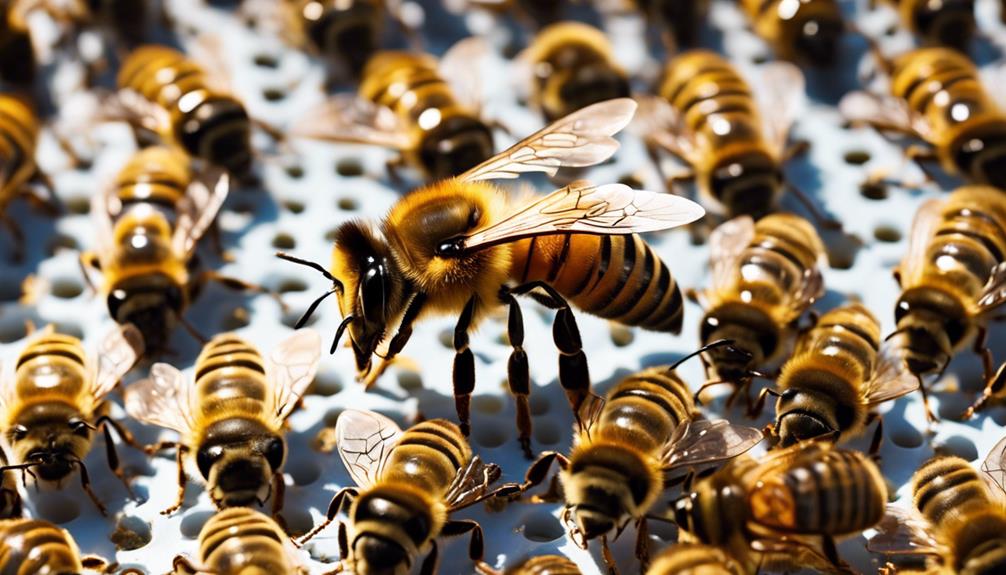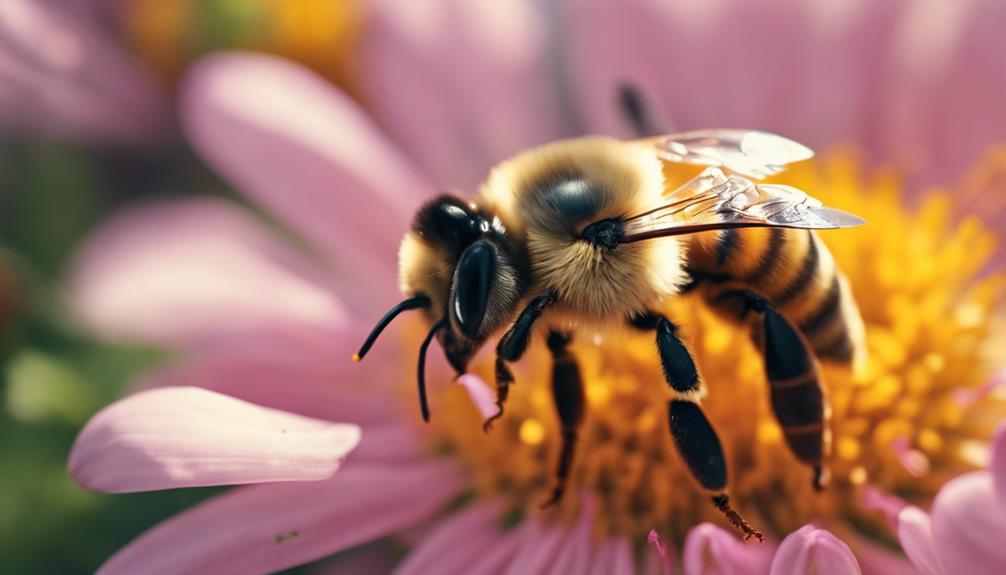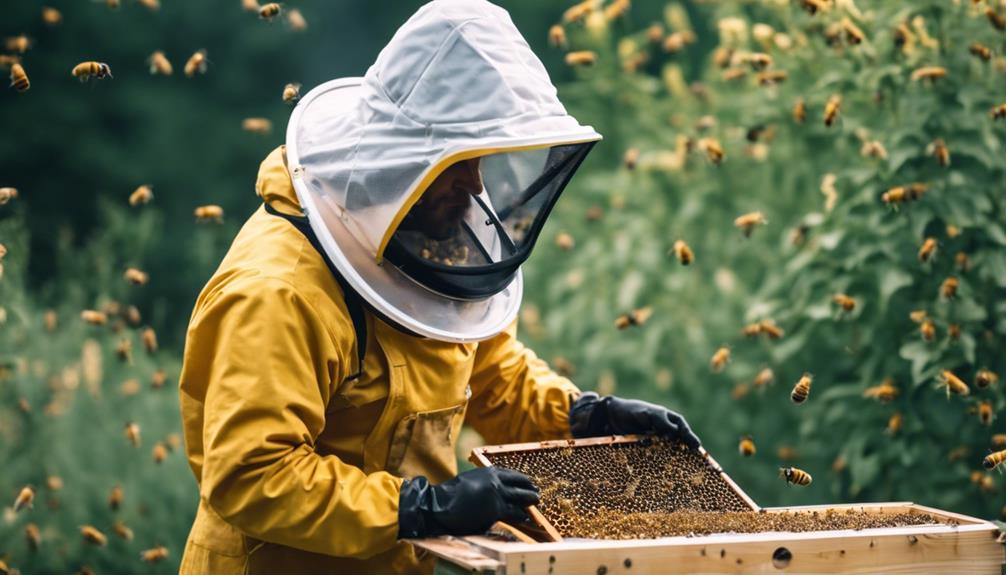In the bustling world of bee colonies, queen bees play a vital role in caring for worker bees. They demonstrate leadership through the use of pheromones, which direct worker behavior and maintain hive unity. By laying eggs and communicating effectively, queen bees nurture a harmonious environment, necessary for the hive’s success. Worker bees rely on these cues for organization and task allocation, displaying a complex social structure that highlights the interdependence within the colony.
The queen’s influence extends beyond mere guidance, impacting the overall productivity and cohesion of the hive. Explore more about the intricate dynamics between queen and worker bees to reveal the fascinating intricacies of hive life.
Main Points
- Queen bees care for worker bees by regulating tasks through pheromones.
- They rely on worker bees for sustenance and hive well-being.
- Queen bee’s health affects worker bee productivity and colony success.
- Mutual support system exists for maintaining hive harmony and efficiency.
- Worker bee loyalty and dedication demonstrate queen bee care.
Importance of Queen Bee Behavior
In understanding the importance of Queen Bee behavior, we witness a remarkable demonstration of care and leadership within the hive. The Queen bee plays an essential role in the colony’s survival by laying eggs, ensuring the continuous growth and sustainability of the hive.
Through the production of pheromones, she communicates with the worker bees, influencing their behavior and fostering unity among the members. This communication is pivotal as it conveys the Queen’s reproductive status and quality, guiding the worker bees in their duties.
The Queen bee’s care for the worker bees goes beyond just laying eggs; she relies on them for sustenance, grooming, and overall well-being, creating a harmonious environment essential for the hive’s success.
Communication Through Pheromones
Exploring the intricate world of bee communication reveals a fascinating reliance on pheromones to convey essential information within the hive. Queen bees utilize these powerful chemical signals to guide the behavior of worker bees and maintain the unity of the colony. Through the release of specific pheromones, queen bees can regulate the tasks and activities of worker bees, ensuring the smooth operation of the hive.
These pheromones not only communicate the queen’s presence but also indicate the colony’s status, influencing the overall organization and behavioral regulation within the hive. Worker bees, in turn, respond to these pheromones by adapting their actions to support the queen and contribute to the collective success of the colony. In this way, pheromones play a crucial role in fostering hive unity and harmonious interactions among the bees.
Impact on Worker Bee Decisions

Worker bees, though having some autonomy, are significantly influenced by the signals and pheromones released by the queen bee. These chemical cues guide worker bees in their tasks and help maintain the overall dynamics of the hive.
Understanding the impact of queen bee communication on worker bees sheds light on the intricate social structure within a bee colony.
Worker Bee Autonomy
Amidst the hive’s bustling activities, worker bees exercise their autonomy in decision-making, contributing to the hive’s collective functioning. Unlike a strict top-down approach, worker bees engage in tasks like choosing nesting sites through a voting system, showcasing a more democratic hive dynamic.
The queen’s influence on worker bee decisions is subtler, allowing for individual and group preferences to shape outcomes. This autonomy empowers worker bees to adapt to environmental changes swiftly and efficiently, driving the hive’s productivity. By valuing each worker bee’s input and allowing for a degree of self-governance, the hive operates as a cohesive unit where decisions reflect the collective wisdom of its members.
Worker bee autonomy not only improves the hive’s efficiency but also fosters a sense of ownership and responsibility among its inhabitants.
Queen Bee Influence
Queen bees wield their influence over worker bee decisions primarily through pheromones and chemical signals, shaping the hive’s collective behaviors and tasks. This guidance from the queen plays an essential role in maintaining order and productivity within the colony.
Here’s how her influence impacts the hive dynamics:
- Enhanced Communication: The queen’s pheromones serve as a form of communication, allowing her to convey specific messages to the worker bees effectively.
- Task Allocation: Through chemical signals, the queen can influence which tasks worker bees prioritize, ensuring the smooth functioning of hive activities.
- Social Cohesion: By regulating worker bee decisions, the queen contributes to the overall social cohesion and organization within the colony, fostering a harmonious environment for all bees.
Hive Dynamics
Within the intricate dynamics of the hive, the influence of hive dynamics on worker bee decisions is paramount for the colony’s functioning. Queen bees, through their pheromones and signals, guide worker bees in tasks essential for hive productivity.
Worker bees, ever attentive to the queen’s needs, from feeding to grooming, rely on these cues to organize their roles effectively. The queen’s health and behavior directly impact the productivity of worker bees, shaping the hive’s unity and efficiency.
The subtle yet powerful communication within the hive guarantees that tasks like foraging, nursing, and maintenance are carried out harmoniously. This orchestration, driven by the queen’s influence, showcases the remarkable interconnectedness of the hive and highlights the critical role of hive dynamics in sustaining the colony’s success.
Queen Bees Reproductive Influence
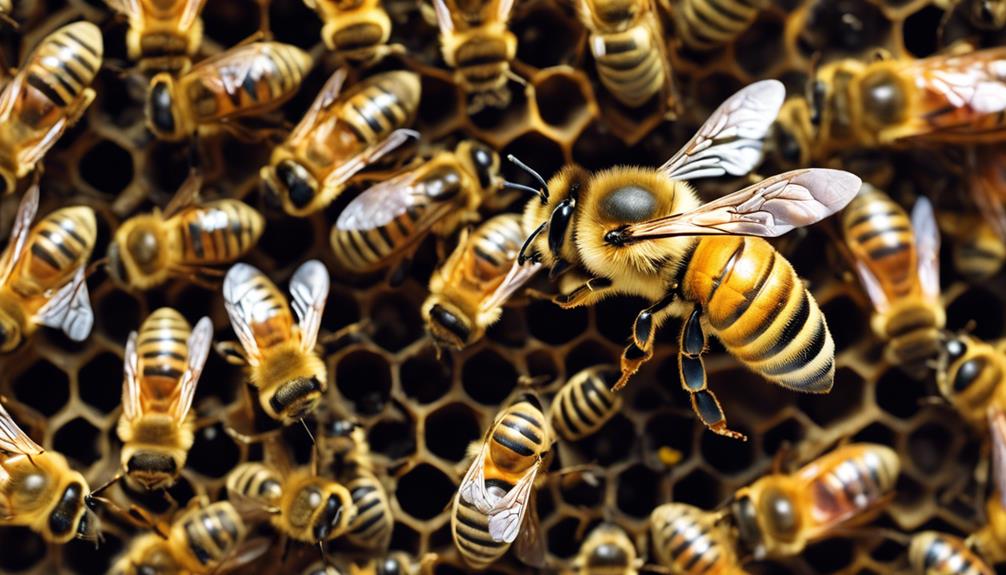
With their remarkable ability to lay up to 2,000 eggs daily, queen bees wield a significant reproductive influence within the hive. This influence goes beyond mere numbers; it shapes the genetic diversity and future of the colony. As the queen honey bee fulfills her role, several aspects come into play:
- The laying of thousands of eggs not only guarantees the hive’s population but also determines its strength and resilience.
- Through the use of pheromones, queens communicate their reproductive status, guiding worker bees in their supportive roles.
- The presence of queen cells signifies the hive’s readiness to expand and shows the queen’s impact on colony growth.
Queen bees aren’t just prolific egg producers; they’re the driving force behind the hive’s prosperity and continuity.
Role in Colony Health
Queen bees are essential for the overall health of a colony. Their pheromones help regulate worker behavior and unity. The queen’s role in laying eggs directly impacts colony growth and sustainability, showcasing her pivotal importance.
Without the queen’s support and reproductive success, the health and productivity of the entire colony would be at risk.
Worker Bee Support
Support from worker bees is essential for maintaining the overall health and productivity of the hive. Worker bees not only care for the queen but also contribute significantly to the hive’s well-being.
Here are some key ways in which worker bee support impacts the colony:
- Nutrition: Worker bees provide food to the queen bee, ensuring she stays healthy and can focus on her egg-laying duties.
- Protection: Worker bees safeguard the queen from potential threats, allowing her to fulfill her reproductive role without interruptions.
- Communication: Through pheromones, worker bees and the queen bee stay connected, fostering unity and coordination within the hive.
Together, these actions by worker bees sustain the queen bee and the entire colony, promoting a thriving and harmonious environment.
Colony Health Impact
In maintaining colony health, the role of worker bees in supporting the queen extends beyond mere caretaking duties to encompass an essential symbiotic relationship important for hive functionality. Queen bees emit pheromones that regulate worker bee behavior, directly influencing colony health.
The unity and productivity of the hive rely on the queen’s well-being, showing her support for the worker bees through indirect means. Worker bees, in turn, depend on the queen’s pheromones for guidance and coordination, underscoring her critical role in looking after the colony.
The queen’s health impacts the morale and efficiency of worker bees, emphasizing her influence on the hive’s well-being. By laying fertilized eggs, the queen guarantees the growth and sustainability of the worker bee population, demonstrating her concern for the future of the colony.
Dynamics of Queen-Worker Relationship

Within the hive, the intricate interactions between the queen bee and the worker bees shape the colony’s functionality and coherence.
- The queen bee relies on worker bees for essential tasks like food provision and grooming, demonstrating a mutual care dynamic within the hive.
- Worker bees, in turn, support the queen’s egg-laying productivity and overall well-being, highlighting the collaborative nature of their relationship.
- The queen’s survival and reproductive success are paramount for the colony’s health, emphasizing the critical role worker bees play in ensuring the queen’s needs are met.
These interdependent relationships, guided by pheromones and productivity goals, are fundamental to maintaining the unity and efficiency of the entire colony.
Support for Worker Bee Activities
Amidst the bustling activities of the hive, queen bees actively contribute to worker bee tasks by laying eggs to sustain the colony population. These eggs aren’t just about increasing numbers; they’re essential for the colony’s survival and the queen’s reproductive success.
By producing pheromones, queen bees also play a significant role in regulating worker bee behavior and coordinating their tasks within the hive. The health and productivity of worker bees are important for ensuring the queen’s well-being and longevity.
In return, worker bees dutifully care for the queen, attending to her needs and supporting her role in the hive. This mutual support system between queens and worker bees highlights the intricate balance and interdependence within the colony.
Queens Contribution to Hive Harmony
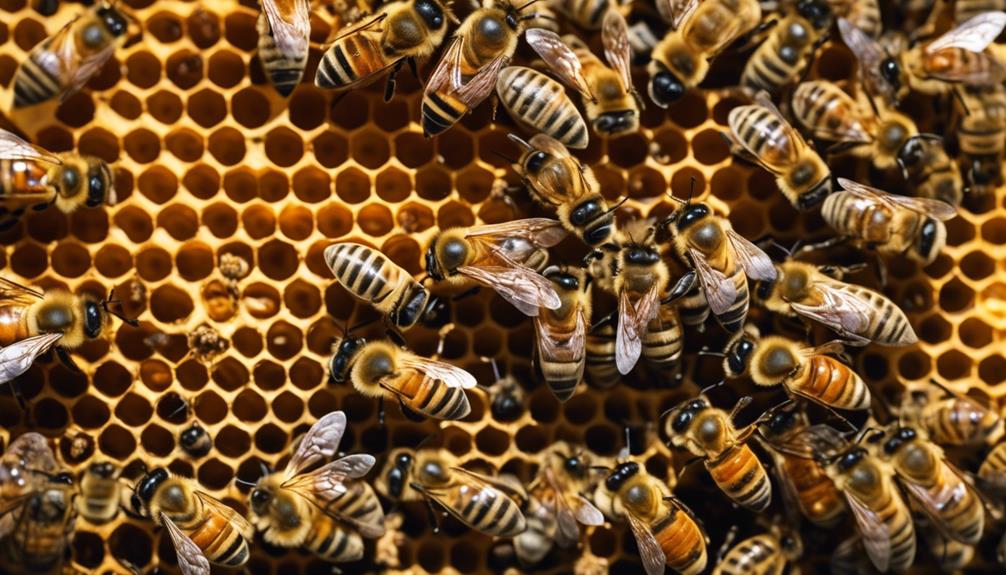
Supporting the hive’s harmony, queen bees contribute significantly through the production of pheromones that regulate worker bee behavior. These chemical signals are essential for communication within the colony, ensuring smooth operations and coordination among the bees.
The loyalty and dedication shown by worker bees towards caring for the queen reflect a deep sense of interdependence within the hive. This mutual respect and support create a harmonious environment where each member plays an important role in the overall success of the colony.
Through efficient communication via pheromones, the queen bee guides the worker bees, fostering a sense of unity and purpose that ultimately benefits the entire hive.
Implications for Bee Population Sustainability
To ensure the long-term survival of bee populations, it’s vital to contemplate the implications of queen bees’ care for worker bees on overall hive sustainability. Queens play a pivotal role in maintaining hive unity by releasing pheromones that keep the colony organized and efficient. Their dedication to the well-being of worker bees, who in turn support the queen’s reproductive success and contribute to hive health, is essential for the entire colony’s thriving.
The queen’s influence on worker behavior underscores her commitment to the collective success of the hive. By ensuring that worker bees have the resources and environment they need to flourish, queens indirectly showcase their care for the sustainability and longevity of bee populations.

Hello! My name is Noel Calvin. I graduated from UCLA and now work as a writer at Launch Ninjas. I write blog posts that inspire and guide our readers in their entrepreneurial pursuits. I live in Pleasantville, NJ, with a peaceful yet lively atmosphere that inspires me.
Writing stories is more than just a job for me. It allows me to share my observations and satisfy my curiosity about the world. I combine my analytical skills with creative enthusiasm to delve into technology trends and startup stories. But my life isn’t limited to screens and keyboards. I value loyalty, passion, and a touch of old-fashioned charm, which I infuse into every narrative I create.
I love spending time in my garage, jamming with my band when I’m not writing. Playing the guitar and singing bring me immense joy. I also enjoy capturing ordinary and extraordinary moments through my camera lens and exploring new culinary adventures that excite my taste buds. I’m always seeking new experiences.
My family is very important to me. Joyful Sunday brunches filled with laughter and intense board game nights keep me grounded, reminding me of life’s simple pleasures.
In my world, every moment is an opportunity for discovery. Every discovery is a story worth sharing, whether a heartfelt moment at home or the pulse of technological innovations. Join me as I navigate through life, one blog post, one guitar strum, and one heartwarming family dinner at a time.
